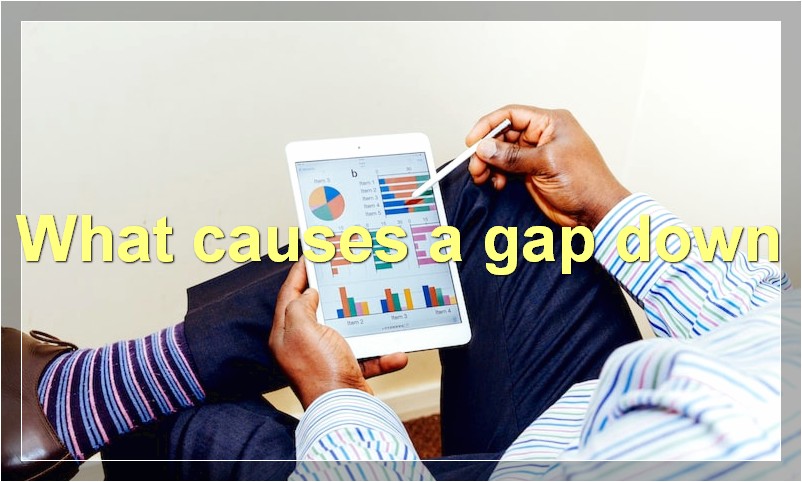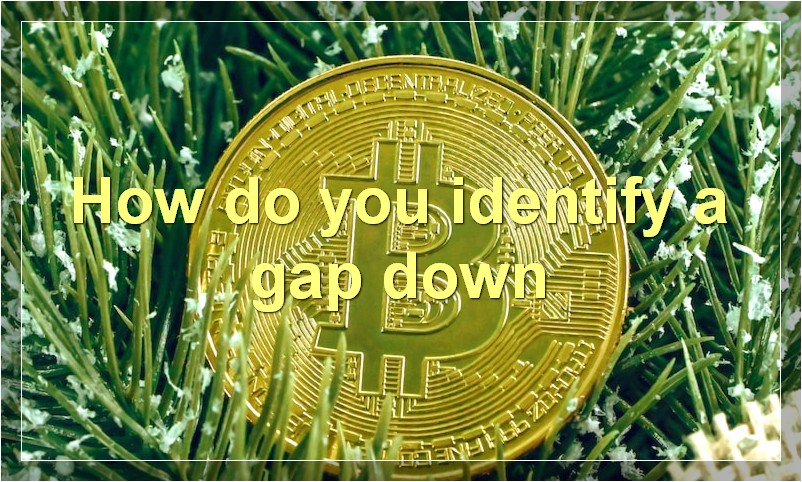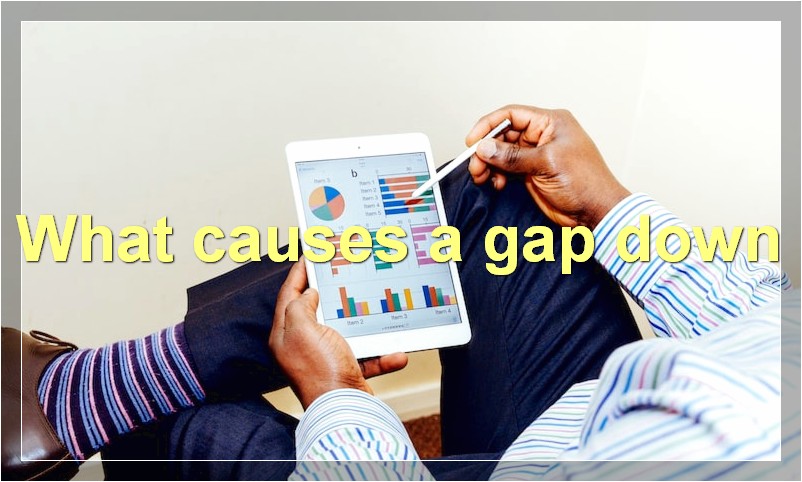If you’re looking to trade a gap down, there are a few things you should keep in mind. First, it’s important to identify the reason for the gap. Is it due to news or earnings? Once you know the reason for the gap, you can make a more informed decision about whether to trade it. If you do decide to trade it, be sure to use stop-loss and take-profit orders to protect your position.
What is a gap down
A gap down is when the stock market opens lower than it closed the previous day. This can be caused by a number of factors, including bad news about a company, poor economic data, or political turmoil. When there is a gap down, it can signal that investors are losing confidence in the market and selling their stocks.
What causes a gap down

When a publicly traded company announces bad news, its stock price usually falls. This is because investors sell the stock, driving the price down. Sometimes, the price falls so quickly that there is a “gap down.”
A gap down occurs when the price of a stock opens lower than it closed the previous day. This means that there was a significant drop in price overnight, which can indicate that there is more selling pressure on the stock. Gap downs can be caused by a variety of factors, including earnings misses, guidance cuts, and negative analyst reports.
Gap downs can be especially harmful to investors who are “long” on a stock, meaning they own shares and hope the price will go up. If the price gaps down, they may be forced to sell their shares at a loss. For this reason, it’s important to be aware of the potential for gap downs when investing in stocks.
How can you trade a gap down
When a stock gaps down, it opens at a lower price than it closed the previous day. This usually happens because of bad news that came out after the market closed. For example, if a company misses earnings expectations, its stock might gap down the next day.
If you think the stock is still a good value despite the bad news, you can trade it by buying at the current market price. You might also put in a limit order slightly below the current price, in case it falls further.
Of course, you need to be careful when trading a stock that has gapped down. The stock could continue falling if the news is really bad. It’s important to do your research and make sure you understand why the stock has gapped down before you make any trades.
What are the risks of trading a gap down
When a stock price “gaps down,” it means the price opened lower than it closed the previous day. This usually happens after a company announces bad news, and investors sell off the stock. If you’re thinking about buying a stock that has gapped down, you should be aware of the risks involved.
The first risk is that the stock might not recover. If the company’s bad news was a one-time event, the stock price might eventually rebound. But if the company is in trouble, the stock price could keep falling.
Another risk is that you could end up paying more for the stock than you wanted to. If you set a limit order to buy the stock at $10 per share, but the price gaps down to $9, your order will be filled. So you’ll end up paying $9 per share instead of $10.
Finally, you could get burned by a “bear trap.” This happens when a stock gaps down, and then rallies back above the previous day’s close. This tricks some investors into thinking the stock is going up, when it’s actually going down.
So, if you’re considering buying a stock that has gapped down, make sure you understand the risks involved.
What are the benefits of trading a gap down
When a stock “gaps down,” it means that the stock opens at a lower price than it closed the previous day. A gap down can happen for a variety of reasons, but often occurs when a company releases disappointing earnings news after the market close.
There are two main benefits to trading a gap down. First, you have the potential to make a quick profit if the stock starts to rebound right away. Second, you can use the gap down as an opportunity to buy a stock that you were interested in anyway but thought was too expensive. If the stock gaps down and then starts to recover, you’ve essentially bought it at a discount.
Of course, there are also risks associated with trading a gap down. The biggest risk is that the stock continues to fall and never recovers. This is why it’s important to do your homework before buying any stock, even if it has gapped down. You need to make sure that the company is still sound and that there is a reason to believe that the stock will eventually rebound.
How do you identify a gap down

A gap down is when the price of a security falls sharply in trading, opening at a lower price than it closed the previous day. This usually happens overnight or during market hours, and can be caused by a number of factors, such as news announcements or a sudden sell-off.
If you’re looking at a chart and see that the price has dropped sharply from the previous day, with little or no trading in between, then you’ve identified a gap down. Gaps can be either up or down, but a gap down is typically seen as a bearish sign, as it indicates that sellers are in control.
Of course, not all gaps are created equal, and some may simply be the result of normal market volatility. So, it’s important to take a closer look at the context before making any decisions. If there’s been a recent news event that could be driving the selling pressure, then it’s more likely that the gap is meaningful. Otherwise, it could just be noise.
What is the difference between a gap down and a regular downtrend
There are a few key differences between a gap down and a regular downtrend. First, a gap down occurs when the price of a security opens lower than it closed the previous day. This means that there is a clear break in the price action, which can signal a change in market sentiment. Additionally, a gap down is often followed by heavy selling pressure, as investors rush to exit their positions. Finally, a gap down typically results in a sharp decline in prices, whereas a regular downtrend is more gradual.
Overall, the main difference between a gap down and a regular downtrend is the size and speed of the price movement. Gap downs are usually much more dramatic and can signal a major shift in market sentiment. If you see a gap down on your charts, be sure to pay close attention to the price action that follows, as it could be an indication of where the market is headed next.
What is the difference between a gap down and a breakout
A gap down is when the price of a security falls below the previous day’s low. This creates a “gap” on a candlestick chart. A breakout is when the price of a security moves above a resistance level or down below a support level.
Is it always profitable to trade a gap down
Gap trading is a risky business. When a stock gaps down, it opens up a can of worms for the trader. The stock may continue to fall, or it may recover and gap up. If the stock falls, the trader is stuck with a losing position. If the stock gaps up, the trader may miss out on profits.
What are some things to be aware of when trading a gap down
When a stock gaps down, it can be an indication that there is bearish news surrounding the company. This can make the stock more volatile and difficult to trade. Some things to be aware of when trading a gap down include:
-The reason for the gap down. Is there negative news surrounding the company? If so, is it priced in?
-The level of support and resistance. Where do you expect the stock to find support or resistance?
-Your own risk tolerance. Gapping stocks can be volatile and risky. Make sure you are comfortable with the level of risk before entering a trade.

